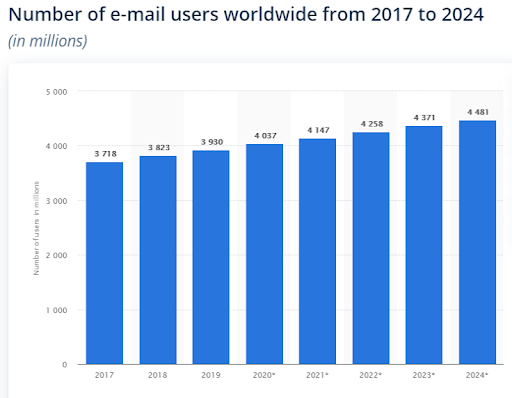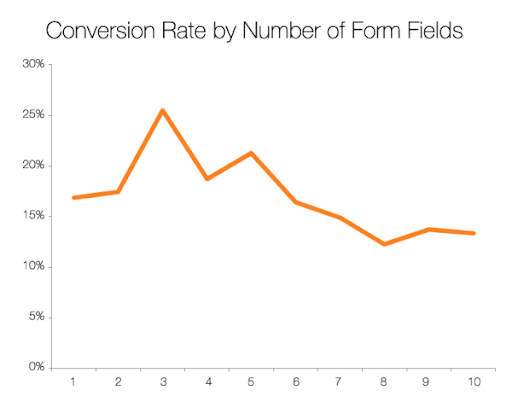Your blog is not just a platform to share information with your audience.
It serves many other purposes.
And one such purpose is lead generation.
Yes, you can use your blog to build an email list. An email list that you can use to achieve your business goals.
In this post, I will show you how to get more email opt-ins through your blog.
And if you’re wondering why you should listen to me, let me give you a brief background about me.
I’m Adam Enfroy, and I launched my blog, AdamEnfroy.com, in 2019. Since then, I’ve scaled it to 500k monthly readers and over $100,000 in monthly revenue.

Part of my strategy to get to this point was building an email list (currently has over 46k subscribers) using the strategies I’ll share with you.
Before we get to the strategies that will help you get more email opt-ins from your blog, let’s quickly build the case email.
Why Building an Email List Important
Despite new communication technologies that have come up in the past few years, email still remains one of the most effective for marketing purposes. That’s why your email list is one of your most important business assets.
And that’s the main reason you must build an email list… Whether done yourself or by hiring an email marketer to do the job for you.
Other reasons include:
Email is Widely Used
There are over 4 billion email users worldwide.

This makes email the most used communication platform on the planet. As a business, your main marketing goal is to find platforms where your audience is and reach out to them there. And email is one of the best ways to do this.
Email is Personal
Unlike other modern communication channels, email is still the most personal space. That is why people will readily follow you on social media but think twice about allowing you into their inboxes. Once your reader grants you access into their inbox, they’re highly likely to read your email.
Because email inboxes are personal, it becomes easier for you to build relationships with your subscribers.
You Own Your Email List
Let’s face it. Most platforms you use to build and grow your audience are not yours. If they’re to sink, your hard work will vanish overnight. However, your email list is yours. Even if your email service provider (ESP) stops operating, you’ll still have your email list.
Now that you know the “why” behind building an email list, let’s get more email opt-ins for your blog.
Get More Email Opt-ins From Your Blog with these 7 Tips
I’m sure you’re rearing to get started building your email list. So let’s get right to it. Fortunately, most of them are low-cost and easy to implement so that you can get started right away.
Tip #1: Drive Traffic to Your Blog
To get more email opt-ins from your blog, you must drive traffic to it.
Organic traffic is one of the best ways you can grow your email list. After all, if they’re coming to your blog. That means they’re interested in the information you have to share.
And one of the easiest ways to ensure that your blog gets tons of visitors is to get it started the right way. I share how to do so in my guide on how to start a blog.
So what are some ways to drive traffic?
Here are some suggestions:
- Guest Posting on relevant blogs
- Build backlinks to increase organic rankings
- Emailing your existing list
- Writing answers on Quora
- Creating pins for articles on Pinterest
- Linking to your blog from Youtube videos
- Posting your articles to Facebook
- Outreaching to influencers to share your content
Tip #2: Create Content Worth Coming Back For
My second tip to getting more email opt-ins is to create content worth coming back for. As research shows, you must invest in quality content that over 6.4 million blog posts go live each day.
For people to subscribe to your blog, your content must be unique. It mustn’t just add to the noise online.
To create quality content that your audience loves, you must:
- Know your audience.
- Understand their pain points and aspirations.
- Use facts, data, and research to build your case.
- Create a content strategy to ensure your content has organization to it.
If you can provide your readers with valuable content, they’ll want to be kept in the loop concerning when you’ll publish your next blog post. And that is incentive enough for them to opt-in to your email list.
Tip #3: Use Pop-ups Wisely
Pop-ups are a great way to catch subscribers while they’re on your blog.
However, you must be careful with the way you use them as they can be annoying to your readers. To avoid this, make sure your pop-ups are unobtrusive and easy to clear.
One of the best ways to ensure that your pop-ups don’t annoy your readers is to make them trigger-based. For example, you can set a pop-up to be triggered after a certain period.
Another example is one of the best types of pop-ups — the exit intent pop-up. Here’s how I use them on my blog:

Notice how I design mine to be like a landing page. I just don’t ask people to sign up for my blog. I invite them to something worthwhile — a vibrant community from which they can learn to grow their blogging business.
Take a look at the exit popup that Chris uses on this blog.

His popup uses curiosity in the headline to get the opt-in.
What’s his best bonus?
How can I use it to earn a high ticket affiliate commission?
You’ll have to opt in yourself to find out. This can be implemented by a tool like ConvertBox.
Tip #4: Create an Irresistible Lead Magnet (And Promote It)
Once people start visiting your blog regularly, there is no guarantee that they’ll opt-in for your mailing list. Sometimes they need a small push to do so.
And one of the best ways to give them that push is to offer a lead magnet on your blog.
A lead magnet is a valuable resource that you offer your readers in exchange for their contact information. For your lead magnet to succeed at encouraging visitors to sign up, it must provide value for your readers. It must either provide useful information or help them solve a particular problem.
Examples of lead magnets you can use to get your readers to subscribe to your blog include:
- Ebooks
- Software
- Funnels
- Templates
- Checklists
- Cheatsheets
To ensure that you attract quality subscribers, avoid generic lead magnets like money, gift cards, electronic devices, etc.
Instead, create lead magnets that appeal to your target audience.
You want a lead magnet that your audience will readily give up their details for.
For example, one of the lead magnets that Chris uses on this blog is a free license of the Link Wizard link tracking software.
This is a software that normally costs $47 a month. So he’s providing enormous value by giving it away for free.
But you will get better results by creating even more targeted lead magnets.
If you take a look at Chris’ Legendary Marketer review he offers a Legendary case study lead magnet.
Since people coming to this post are searching for more information about Legendary Marketer, the conversion rate for this lead magnet will be much better.
And the stats bear this out.

This almost 6% opt-in rate is much better than the standard 1-2% opt-in rate you would get with a more generic lead magnet.
Tip #5: Make Opting In Simple
A blog is one of the most effective lead generation tools in your arsenal. But for it to succeed in doing this, you must make it easy for your visitors to opt-in.
If there’s one thing people don’t like, it’s to exert physical and mental effort into completing a task. One of the best ways to make your form easy to fill is to reduce the number of form fields. A Hubspot study found that the optimum number of fields is three. More than that, and the conversions drop.

In most cases, the only form fields you’ll need are the name and email address fields.
Other ways of making opting in easy include:
1) Make Your Form Mobile-friendly
We’re living in a mobile-first world where most digital content consumers are on handheld devices. Make it easy for those reading on mobile devices to fill in your form by making the fields big enough to tap with the finger. Also, use single-column fields to provide a positive user experience (UX).
2) Allow Users to Sign Up Using Social Media
To speed up the signing-up process, embed a social media sign-up button on your forms. It also makes it easy for your readers as they won’t have to create and remember another password. Doing so provides better customer service thanks to the convenience of social media.
As long as your form is easy to fill, the likelihood of your visitors signing up is higher. So, make sure to design forms that are easy to fill.
Tip #6: Reach Out to Commenters
People who leave comments on your blog posts are to be treasured. They have expressed interest in your content and show that they’re interested in interacting with your blog. And they’re highly likely to engage with your emails as well.
That’s why you must reach out to them and ask them to subscribe to your blog.
Thankfully, this is really easy to do.
For example, you can use Yoast Comment Hacks. It’s a WordPress plugin that allows you to redirect commenters to a “Thank You” page.
You can then use the Thank You page to ask them to subscribe to your email list. To get even more people opting in, make sure to include your lead magnet as well.
The comment section of your blog is prime real estate that most bloggers don’t take advantage of. So why not use it, to grow your email list.
Tip #7: Personalize Your CTAs
One critical element that all your strategies hinge on is your call-to-action (CTA).
For your blog visitors to take action, you must craft effective personalized CTAs.
Personalized CTAs don’t have to feature a name. After all, at this point, you haven’t collected any details from your readers.
To be personalized, your CTAs have to be relevant and address your customers’ pain points.
Here’s an example from the OptinMonster blog:

One of the blog’s main themes is conversion optimization. Readers are drawn to the blog because they want to improve the conversion rates of some aspects of their marketing and sales funnels.
Notice how the CTA addresses that pain point. That’s personalization.
To create these types of personalized CTAs, you really need to understand your audience and their main pain points.
Final Thoughts
Growing your email list should be one of your main marketing goals.
After all, you can use email to achieve several business objectives like customer retention and driving sales, among many others.
Simply put, the growth of your email list will lead to the growth of your business. And if you leverage your email list well, you can nurture your subscribers and convert them into customers.
Try to utilize as many of the strategies mentioned in this article as you can, and you will definitely see your subscriber base grow.

